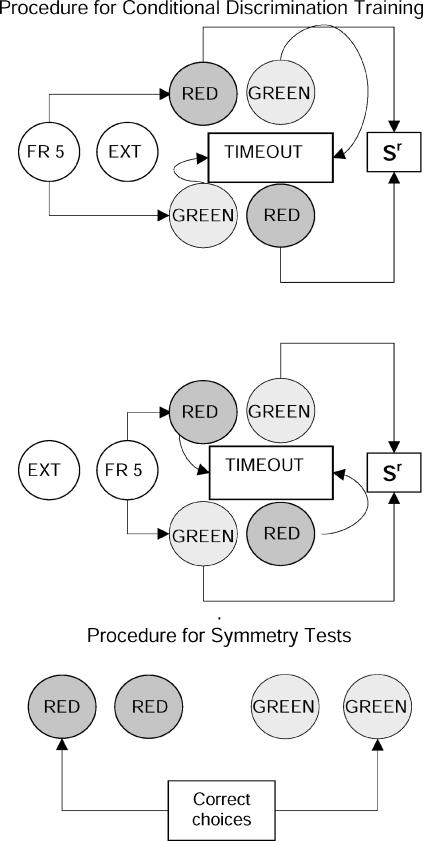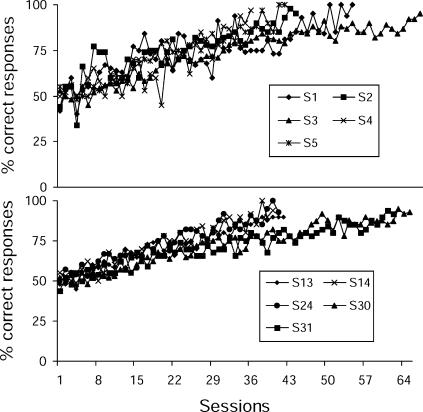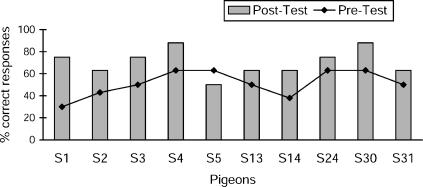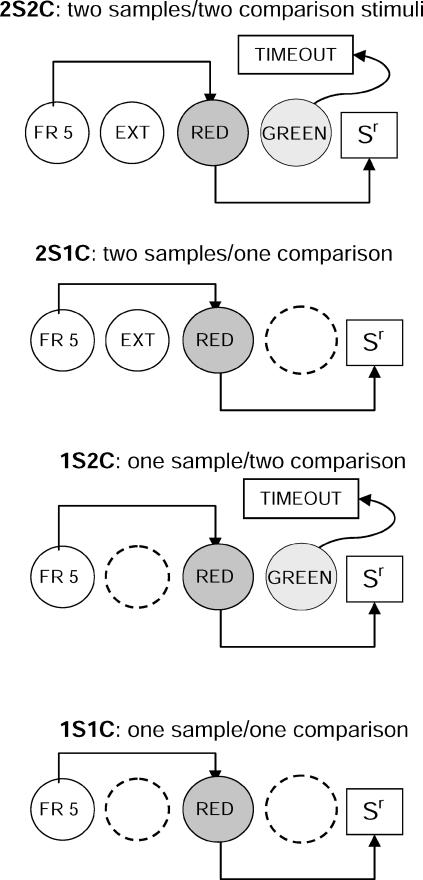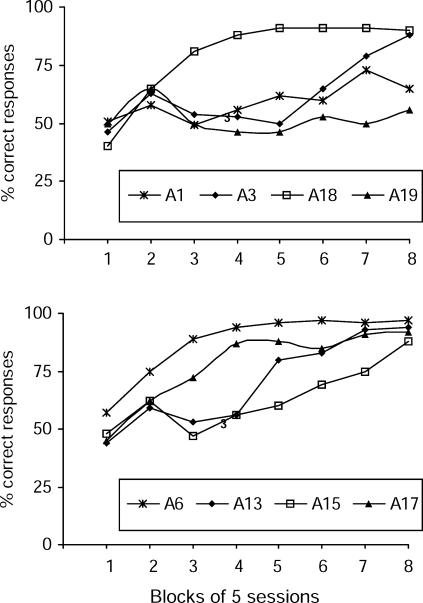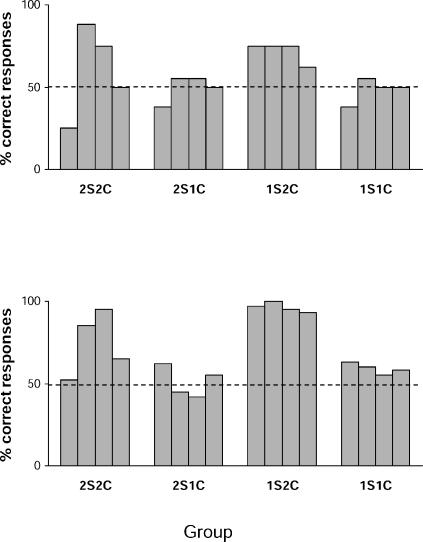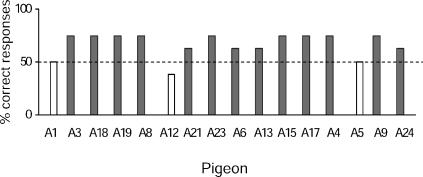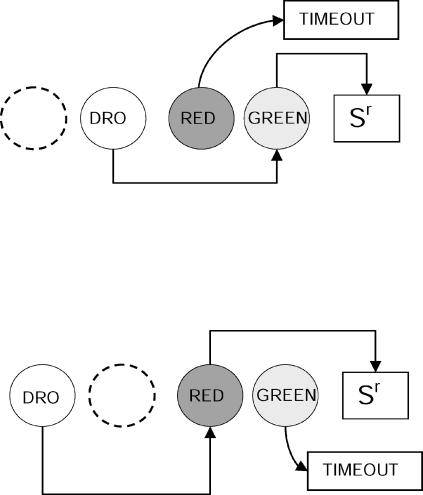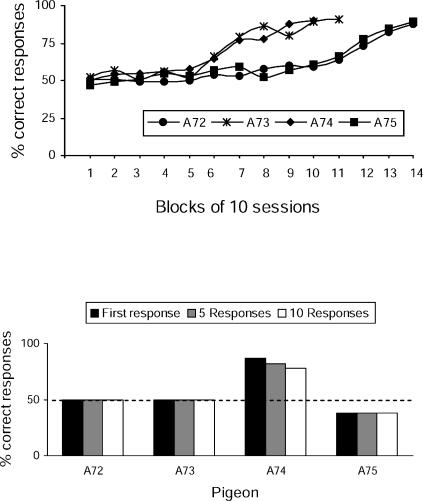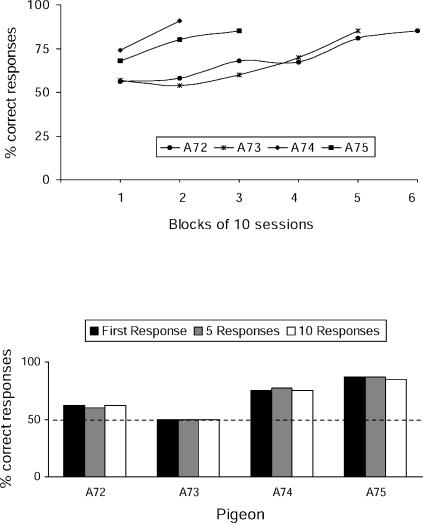Abstract
In Experiment 1, 10 pigeons were exposed to a successive symbolic matching-to-sample procedure in which the sample was generated by the pigeons' own behavior. Each trial began with both response keys illuminated white, one being the “correct” key and the other the “incorrect” key. The pigeons had no way of discriminating which key was correct and which incorrect, since these roles were assigned on a random basis with the same probability of 0.5 for each key. A fixed ratio of five responses was required on the correct key. However, each time the pigeon pecked the incorrect key, the correct key response counter reset. Five consecutive pecks on the correct key was the only way to end this component, and switch off both key lights. Two seconds later, these same keys were illuminated again, one green and the other red (comparison stimuli). Now, if the correct white key had been on the left, a peck at one color produced food, and if the correct white key had been on the right, a peck at the other color produced food. When the pigeons had learned this discrimination, they were exposed to several symmetry tests (simultaneous presentations of both keys illuminated the same color—i.e., both red or both green), in order to interchange the sample with the comparison stimuli. In Experiment 2, the importance of requiring discrimination between the samples and between the comparisons was analyzed. In Experiment 3, we compared the results of Experiment 1 with a slightly different experiment, which resulted in discrimination of key position, an exteroceptive stimulus. The results showed that symmetry emerged only when different responses were used as samples.
Keywords: stimulus control, equivalence relations, symmetry, conditional discrimination, matching-to-sample, differential response, key peck, pigeons
The usual way to obtain the phenomenon of stimulus equivalence classes is to train subjects in a standard conditional discrimination procedure (Sidman & Tailby, 1982). During this training, if a consistent relationship is established among three otherwise dissimilar stimuli (a and b, b and c), the following relations (R) frequently occur in the absence of specific training: aRa, bRb, cRc (reflexivity); bRa, cRb (symmetry); aRc (transitivity) and cRa (equivalence).
It is well documented that the emergence of equivalence classes between stimuli is obtained when human beings with verbal ability are used (Dugdale & Lowe, 1990; Hayes & Hayes, 1989; Sidman, 1994). However, the current consensus is that equivalence, according to widely adopted criteria proposed by Sidman, has not yet been demonstrated in subjects (Dugdale & Lowe, 2000; Zentall & Smeets, 1996).
From the different emergent relationships included in equivalence classes, symmetry has turned out to be crucial with respect to the differences between human beings and other species. In nonhuman animals, there is some evidence (Hearst, 1989; Honey & Hall, 1989) for the development of symmetrical relations following Pavlovian conditioning training (backward associations), although negative results have been the most common findings in symmetry tests using nonhuman subjects (Gray, 1966; Hogan & Zentall, 1977; Lionello-DeNolf & Urcuioli, 2002; Richards, 1988; Rodewald, 1974; Sidman et al., 1982). One positive report (McIntire, Cleary, & Thompson, 1987) may depend on directly conditioned chains of mediating behavior (Dube, McIlvane, Callahan, & Stoddard, 1993; Hayes, 1989; Saunders, 1989). Even in studies in which emergent equivalences have been found (e.g., in sea lions, Kastak, Schusterman, & Kastak, 2001; Schusterman & Kastak, 1993; in chimpanzees, Yamamoto & Asano, 1995; and in pigeons, Meehan, 1999) the animals initially found it difficult to demonstrate emergent symmetrical relations (i.e., given AB training initially, emergent BA relations were not found). Recently, Frank and Wasserman (2005) reported a case of associative symmetry in the pigeon. They used a successive go/no-go matching-to-sample procedure in which all of the training and testing stimuli were presented in one location and intermixed arbitrary and identity matching trials. They reported robust symmetrical responding, but their procedure differed from that typically used in equivalence investigations with humans in that the pigeons did not view the two comparison stimuli (the correct one and the incorrect one) simultaneously.
The origin of the emergence of untrained relationships between stimuli in equivalence classes has been the center of attention of research in this matter (see García & Benjumea, 2001). There are two main lines of thought within the scientific community. On the one hand, Sidman (1990, 1994, 2000) suggested that stimuli equivalence could be “a primitive,” that is, a basic function which is not derived from other processes, concluding that stimuli equivalence is an emergent property of conditional discrimination training procedures. According to this “primitive” hypothesis, failure to obtain the emergence of equivalence in animals would have to be resolved through phylogeny in the end.
On the other hand, as pointed out by Dube et al. (1993), positive results using standard equivalence procedures could involve behavioral prerequisites that humans, but not laboratory animals, are likely to have acquired through preexperimental experience. Some authors have postulated that language could be this prerequisite. Perhaps human beings form classes of equivalent stimuli, not because they have a specific innate ability (“primitive”), but because when stimuli appear they name or label them (“Naming Hypothesis”: see for example, Dugdale & Lowe, 1990; Hayes & Hayes, 1989).
Catania, Matthews, and Shimoff (1990) suggested that the bidirectional character of verbal behavior and of stimuli equivalence could be a manifestation of the same behavioral competence: the ability to establish conditional discriminations based on one's own behavior.
Sidman (2000) suggested that the differences found between animals and human beings could be due to critical procedural variables. While accepting that equivalence may be a primitive that arises directly from the reinforcement contingency, we still need to include not only the samples and comparison stimuli but also the responses and reinforcers in the equivalence classes. Viewed in this way, the Naming Hypothesis could be included within this framework without controversy. The crucial factor may be that human beings use different responses (i.e., names and labels) whereas in the procedures normally used with animals the same response (e.g., key peck) would be used for different stimuli.
Evidence exists that rudimentary symmetry is obtained with animals when different responses are used in conditional discriminations. McIntire et al. (1987) trained monkeys to make differential responses to both the sample and the correct comparison, and they found symmetry. Another study which presented positive results with regard to emergent relations was that of Zentall, Sherburner, and Steirn (1992), in which biologically relevant stimuli (unconditional stimuli) were used as samples. In this procedure, what might have happened is that the pigeons really did discriminate and choose the correct comparisons according to the different intense, and therefore more discriminative, consummatory responses that they had carried out in the presence of the different sample stimuli. Along the same lines, one of the most relevant factors in the work of Meehan (1999) was the use of differential reinforcers for each of the classes that he was trying to obtain in his experiment. As he himself commented, this use of different reinforcers generated different behavioral patterns to each sample. As we already have suggested, those patterns were probably the events discriminated by the pigeons in that work (see also Urcuioli & DeMarse, 1997).
In all previous studies, different sample stimuli have been used in conjunction with different responses. However, there also exists the more straightforward possibility of establishing conditional discriminations based exclusively on different responses acting as samples, without being accompanied by different exteroceptive stimuli. Although previous experiments using this type of conditional discrimination exist (Baninger, Kendall, & Vanderwolf, 1974; Lionello-DeNolf & Urcuioli, 2003; Reynolds & Catania, 1962; Shimp, 1982, 1983, 1984), in none of them was the emergence of symmetrical relationships tested.
The aim of the present research, therefore, was to test the emergence of symmetry in a conditional discrimination situation using pigeons as the experimental subjects and their own behavior as the (propioceptive) sample stimulus.
Experiment 1
Method
Subjects
Ten experimentally naïve homing pigeons (Columba livia), which were maintained at approximately 80% of their free-feeding weight, were used. A 12 ∶ 12-hr light ∶ dark cycle was employed in the rooms where the pigeons were housed. Water was always available.
Apparatus
Five standard experimental chambers with two response keys were used. Each chamber was 275 mm high, 240 mm wide, and 320 mm long. One wall of the chamber contained two response keys with white, red, or green 6-W keylights, a houselight, and an opening of 50 mm by 60 mm to provide access to mixed grain. The keys were mounted about 50 mm from the nearest wall and 130 mm from each other, center-to-center. A computer was used to control and record the experimental events.
Procedure
The experiment was divided into three phases: pretraining, conditional discrimination training, and symmetry testing.
Pretraining
After magazine training, three sessions of autoshaping with a conditional stimulus (CS) of 8 s, an intertrial interval (ITI) of 52 s, and a fixed ratio 1 (FR 1) was applied to all the possible key combinations (i.e., white, red, green, in left and right positions). The pigeons were then exposed to a FR 10 schedule to increase the number of responses on the keys. The reinforcer in this phase and all subsequent phases was 3-s access to mixed grain.
Conditional Discrimination Training
A training trial consisted of two consecutive components: a sample component followed by a comparison component. The sample component began with both keys illuminated white. In each trial, one key was assigned as “correct” and the other as “incorrect” with a probability of 0.5. Each time a pigeon pecked on the incorrect key, the correct key counter reset, so five consecutive pecks on the correct key was the only way to end this component which, after an interval of 2 s during which both key lights were switched off, was followed by the comparison component. The comparison component consisted of one key being lit green and the other red, with position randomized. For half of the pigeons, a peck on the red key after previously pecking on the left white key and a peck on the green key after previously pecking on the right white key produced food (left–red/right–green correspondence, see Figure 1: top diagram). For the other half of the pigeons, these relations were reversed (left–green/right–red correspondence). Pecking the incorrect color key was followed by a 10 s time-out (houselight off), and then another presentation of the same comparison component. In this way, we ensured that the same amount of reinforcement was obtained in the presence of each color. Each training session concluded when 40 reinforcers had been delivered. This training phase continued until the pigeon responded correctly on at least 90% of the trials, in each of three consecutive sessions (mean number of sessions: 48.7; range: 35–65).
Fig 1. Top: The conditional discrimination training procedure used in Experiment 1.
The sample was which of the two white response keys was pecked, and the comparison stimuli were the colors red and green (left–red/right–green correspondence). Bottom: Symmetry tests from the previous training.
Symmetry Test Sessions
The symmetry trials (see Figure 1, bottom diagram) consisted of the presentation of both keys illuminated the same color (red or green) and continued until the pigeon made a total of 10 keypecks, regardless of which key was pecked; the pigeon then moved on to the next trial without food presentation.
Each test session consisted of 44 trials, 40 conditional discrimination trials and 4 test trials (two green trials and two red ones). These test trials were interspersed among blocks of 10 consecutive training trials, so the test trials were the 11th, 22nd, 33rd and 44th trials. The probability that the test trial had been preceded by a right or left response or by a response to a red or green comparison stimulus depended upon the type of comparison component associated with the preceding training trial; this had been assigned by the computer at random (see training phase for details). The order of the tests was counterbalanced; half of the sessions started with red tests (11th Red, 22nd Green, 33rd Green and 44th Red) and the other half started with green tests (11th Green, 22nd Red, 33rd Red and 44th Green). Half of the pigeons from each correspondence-trained group started with a red test trial and the other half with a green test trial.
The symmetry sessions were employed on two different occasions: as the baseline in Sessions 3 and 5, when the pigeons were still responding at random on the conditional discrimination task (about 50% accuracy), and after the end of the conditional discrimination training, as a test of the emergence of symmetry. This posttraining test was presented twice: the first session after the performance criterion had been met, which was then followed by another training session, and then again following this training session. Thus, each symmetry test (baseline and posttraining tests) included a total of 80 responses from each pigeon (eight trials of 10 pecks each). All of the trials, in both the conditional discrimination training sessions and the symmetry test sessions, were preceded by an ITI of 10 s, during which only the houselight was on.
Results
Conditional Discrimination
Figure 2 shows percent correct responses for each of the pigeons session by session. The percent correct was calculated from a total of 40 responses per session (one response per trial); the responses given in the correction trials were not included.
Fig 2. Top: Acquisition of the conditional discrimination of the left–red/right–green correspondence pigeons.
Bottom: Acquisition of the left–green/right–red correspondence pigeons.
All of the pigeons attained the criterion of 90% success rate in the conditional discrimination task. The pigeons' position bias in red–green disappeared, as the high percent correct obtained in the discrimination at the end of phase shows. However, a bias did not disappear in white–white, as some of the pigeons mainly started pecking on the left key while others started on the right key, although the white–white component finished when the pigeon made five consecutive responses on the key that was randomly assigned as “correct” by the computer in this trial.
Symmetry Tests
With regard to the interpretation of the symmetry trial results, for the pigeons trained on the left–red/right–green correspondence, the correct responses were: left choices on red trials (when both keys were red) and right choices on green trials (when both keys were green). Complementary to this, the correct responses for the pigeons trained on the left–green/right–red correspondence were: pecks on the left key when both keys were green, and pecks on the right key when both keys were red.
The degree of symmetry was expressed as the proportion of “correct” responses. For instance, if all ten responses were counted, and the first six responses of a pigeon trained on the left–red/right–green correspondence were made on the left red key, and the following four responses were made on the right red key, the proportion of correct responses (i.e., symmetry) was 60% for this trial.
Baseline Symmetry Test
Before the pigeons achieved criterion performance on the discrimination task, their performance in the symmetry test was approximately random: a 50% success rate when we consider the first response in each symmetry trial, 49% when we consider the first five responses, and 52% for all 10 responses. They again showed position biases. Some pigeons always pecked the left key (in both red–red and green–green trials), whereas others always pecked the right key. In either case, the same level of chance responding was observed in the pretest.
Symmetry Test After Discrimination
Figure 3 shows the Experiment 1 symmetry test results for the first response in each test trial. The different pigeons are represented on the horizontal axis and the percentage of correct responses on the vertical axis. The line graph indicates the percent correct obtained by each pigeon in the pretest (before learning the discrimination task) and the bar graph indicates the percent correct for each pigeon in the posttest (after learning the discrimination task). With the exception of Pigeon S5, all the pigeons obtained a higher percent correct in the posttest than in the pretest.
Fig 3. Percentage of correct first responses in the symmetry test carried out during the baseline before the acquisition of the conditional discrimination (line graph) and that carried out after having learned this discrimination (bar graphs).
The mean of 70% success rate, when only the first response in each trial was counted (see Figure 3), dropped to 67% when the first five responses were counted, and to 61% when all ten responses were counted. Since the tests were carried out in extinction (after the training phase with FR 1 and the green and red keys as comparison stimuli), the pigeons switched from left to right or vice versa on many occasions, with the first change being located between the fifth and sixth responses.
An Analysis of Variance on all the test conditions (pre- and posttests for one, five, and ten responses) revealed that there were significant differences (F2,18 = 4.759; p = 0.001). A posteriori contrast analysis was carried out to see which comparisons produced these differences. The Tukey Test showed that these significant differences were obtained when the results for the posttest first response were compared with the results obtained for the pretest first response (p = 0.01), first five responses (p = 0.009), and all ten responses (p = 0.011).
To sum up, compared with their performance in the pretest, 9 of the pigeons improved their preference for the correct option in the symmetry posttests, which were carried out after achieving a 90% success rate in the conditional discrimination task.
This proportion (9 of the 10 pigeons improving their performances between the pretest and posttest) was maintained both when the first response in each test (see Figure 3) and the first five responses were considered, but decreased to 7 out of 10 pigeons when all ten responses in each test were considered. No differences were found between the red–red and green–green symmetry tests, nor between the pigeons trained in the left–red/right–green and left–green/right–red correspondences.
Discussion
This experiment shows that pigeons will spontaneously transfer from a position–color (A–B) matching-to-sample task to a color–position (B–A) test task. A–B was trained, and B–A emerged. Similar results have been widely reported for human subjects, but lack of symmetry has been the most common result for nonhuman animals (Dugdale & Lowe, 2000).
The only source of discrimination for our pigeons in each trial was their own behavior—pecking left versus pecking right. Success in this task could not come under the control of any external event (both keys were white all the time when the pigeons were responding on the sample component). For instance, when a pigeon trained in the left–red association chose red and received food, reinforcement was delivered only because the pigeon's previous behavior had been a left peck.
All of the pigeons were able to discriminate their own behavior in the matching-to-sample procedure. The sample was the position of the last key pecked and the comparison stimuli were the colors of the keys in the following component. There was no evidence of symmetry when the pigeons did not discriminate their own behavior (symmetry pretest). However, after sufficient training in the discrimination task, 9 out of 10 pigeons showed a bias towards the position which was the sample of the color presented on both keys in the symmetry test (see Figure 3).
The consistent biases towards a certain position when both keys were white eliminated an alternative explanation for our results. Bidirectional training might have been produced if, for instance, a pigeon had used the following kind of strategy:
after a left white response, the pigeon chose red and received food, and then its response is once again on the left key and,
after a right white response, the pigeon chose green and received food, and then its response is once again on the right key.
Using such a strategy, the training carried out would not only have been position–color, but also position–color–position. The results shown by the pigeons avoided this possibility.
With our procedure, it is unlikely that either the color or the position reinforced on a particular training trial could have affected the responses given in the following trial because between the two trials the reinforcer was given and there was an ITI of at least 10 s (see Olton, 1978, for interference effects produced by a reinforcer).
After being trained to discriminate and label their own behavior, the pigeons apparently used these labels (colors) to guide their behavior (choice of right or left key). Taking these results as a starting point, we suggest that the pigeon's discrimination of its own behavior provided the basis for the emergence of bidirectional relationships or, at least, that different responses to the sample were necessary.
Since the pigeons had shown symmetry in the context of a task of discrimination of their own behavior, we next analyzed the different components that might have allowed this relation to emerge. In Experiment 2 we assessed the relative importance of having to discriminate between samples and comparisons. In Experiment 3 we compared the results obtained in Experiment 1 with a procedure in which the event to be discriminated was not the pigeon's own behavior but the spatial position of the sample.
Experiment 2
In Experiment 1 we showed that when pigeons are trained to discriminate their own behavior they also show symmetry. In Experiment 2, we tried to analyze the effect of some variables on this emergence of symmetry in pigeons by introducing some modifications to the experimental design. We first considered whether the pigeons in the first experiment could have had some difficulty in learning the exact behavior pattern that would serve as a sample for choosing the correct comparison stimulus. For instance, if a pigeon started a particular trial by pecking the right white key (incorrect), and after five or six responses changed to the left key (correct), after which the comparison stimuli were switched on, and then the pigeon chose red and received food, although the five responses on the left key were the ones that produced the change to the comparison stimuli, the correct red choice might have been associated with “respond several times on the right key, then change to the left key and after that, choose red.” If the pigeon always started pecking on the left or right white key, half of the trials would begin with a few pecks on the incorrect key, followed by five pecks on the correct one, possibly hampering the acquisition of the conditional discrimination and possibly affecting the symmetry test. To sum up, in Experiment 1, we could not guarantee that only the responses given on the correct key in the sample component were associated with the choice of the corresponding color of the comparison stimulus. To avoid this problem, in Experiment 2 we introduced a condition in which only the correct response key was illuminated white and the other was unlit. The problem with this procedure is that the exteroceptive stimulus, the right or left illuminated key, instead of the pigeon's own behavior, could become the real conditional stimulus that controls the subsequent choice of the red or green key. For this reason, a control condition was included with both keys lit white as in Experiment 1.
Another question concerns the role that differential reinforcement may or may not play in the emergence of symmetry. In a standard procedure of symbolic matching-to-sample, each comparison stimulus has a double function: to act as a positive stimulus in the presence of a sample and as a negative stimulus in the presence of the opposite sample. It is possible, however, that the effect of symmetry in Experiment 1 might just be explained as a simple Pavlovian backward association between the sample response and the comparison stimulus. In order to check this hypothesis, we included a condition in which only the correct comparison stimulus was present after each sample, and 100% of these “errorless” forced trials ended with food.
Finally, although Experiment 1 revealed a consistent tendency towards symmetry when the first response of the tests was considered, this consistency gradually decreased as more responses occurred. Even though we have tentatively explained this problem, the performance might be better if we required five consecutive responses to the correct comparison stimulus.
Method
Subjects
The subjects were 16 experimentally naïve pigeons similar to those used in Experiment 1, housed and maintained in the same way.
Apparatus
The apparatus was the same as that described in Experiment 1, except that only four standard experimental chambers were used.
Experimental Design
We used a 2 × 2 experimental design according to the number of keys used as sample stimulus (either one or two white keys) and the number of keys used as comparison stimulus (either two or just the correct color).
Procedure
Pretraining
The procedures used in pretraining were the same as those used in Experiment 1. After magazine training and autoshaping with FR 1 and FR 10 schedules, the pigeons were distributed randomly into four experimental groups with 4 pigeons in each group. Figure 4 shows diagrams of the four experimental conditions.
Fig 4. The conditional discrimination procedures employed with each of the four groups of pigeons in Experiment 2 (red–left/right–green correspondence).
Training
In Group 2S2C (two samples and two comparisons) the training was exactly the same as in Experiment 1, except with a FR 5 (instead of FR 1) schedule required on the correct comparison. In Group 2S1C (two samples and one comparison), the procedure was the same as in Group 2S2C, except that only the correct comparison (red or green) was present. The difference between Group 1S2C (one sample and two comparisons) and Group 2S2C was that only the correct white key (left or right) was lit. Finally, in Group 1S1C (one sample and one comparison) only the correct white key and the correct comparison were lit. This first training phase ended after 40 sessions.
After this training, all the pigeons were assessed for the emergence of symmetry, after which all the pigeons were trained in the 2S2C procedure for a further 30 sessions. At the end of this training another symmetry test was conducted.
Symmetry Tests
These trials were carried out in exactly the same way as in Experiment 1 and were common to all of the groups. The criteria also were the same. When a pigeon from Group 2S2C performed the symmetry test, a yoked-control pigeon from Group 2S1C with the same position–color correspondence did likewise. Furthermore, when a pigeon from Group 1S2C performed the test, one of the pigeons from Group 1S1C with the same position–color configuration did likewise. The pigeons were assessed in symmetry three times: after pretraining, as the baseline; after the first 40 sessions of conditional discrimination training, which was different for each group; and after the further 30 sessions of the 2S2C procedure, which applied to all of the groups.
Results
Symmetry Pretest (baseline)
The pigeons' performance was at chance level, with the mean success rate for all the pigeons being 53% (ranging from 37% to 58%).
First Discrimination Training
For the pigeons from Groups 2S1C and 1S1C no data are available for analysis from this phase because only the correct comparison stimulus appeared in each trial. Figure 5 shows the acquisition data for the other two groups; 2S2C is shown in the top and 1S2C is shown in the bottom graph. As can be seen in the top graph, after 40 sessions, 2 of the pigeons (A3 & A18) from Group 2S2C had learned to discriminate (more than 90% of their responses were correct), whereas the other 2 pigeons (A1 & A19) had not. All of the pigeons from Group 1S2C had learned the task in this number of sessions (bottom graph). When we compare these results with those from Experiment 1, we find that Group 2S2C performed worse (a mean of 74.75% of the choices were correct compared to 87.80% in Experiment 1). However, the results for Group 1S2C revealed better performance than observed in Experiment 1 (92.75 % of the choices were correct).
Fig 5. Top: Acquisition of the conditional discrimination for each pigeon in Group 2S2C.
Bottom: Acquisition of the conditional discrimination for each pigeon in Group 1S2C.
Second Symmetry Test
All the pigeons concentrated all their responses on the same key in each symmetry trial without changing keys, so there was no difference in results for the first response, the first five or all ten in each trial. We therefore focused on the first response in each trial. The top graph of Figure 6 shows the percentage of correct responses given in the symmetry test for the pigeons in each group.
Fig 6. Top: Percentage of correct responses for each pigeon from each experimental group in the symmetry test, after the corresponding conditional discrimination training.
Bottom: Percentage of correct responses given by these pigeons in the first session of the conditional discrimination, when they were faced for the first time (except Group 2S2C) with two samples and two comparisons (second conditional discrimination).
Of the 4 pigeons that composed Group 2S2C, the 2 that had acquired the conditional discrimination showed high symmetry levels. Pigeon A3 scored an 88% success rate and Pigeon A18 scored 75%. The 2 pigeons from this group who had not done better than chance after 40 sessions only scored 25% (A1) and 50% (A19).
In Group 2S1C the results were more homogeneous. Two pigeons (A12 & A21) scored 55%, 1 (A23) scored 50%, and the 4th (A8) had a success rate of just under 40%. All in all, none of the pigeons in this group seemed to show symmetry.
Three of the 4 pigeons from Group 1S2C performed well in the symmetry tests. Pigeons A6, A13, and A15 each obtained 75%. The other pigeon (A17) scored 62%.
The results for Group 1S1C were similar to those for Group 2S1C. One pigeon (A5) achieved a 55% success rate, 2 (A9 & A24) achieved 50%, and Pigeon A4 was correct on 38% of the test trials. Thus, there is no indication of symmetry in this group.
Second Discrimination Training
When all the pigeons were changed to the 2S2C procedure, the pigeons from Group 1S2C started with a correct response level of nearly 100%, but Groups 2S1C and 1S1C began near chance. The bottom graph in Figure 6 shows percent correct choices of red and green in the first session of the training. The performance of the pigeons in Groups 2S2C and 1S2C was similar to that shown in the first 40 sessions, whereas Groups 2S1C and 1S1C (trained with only the correct comparison stimulus) averaged a 50% success rate in the first session of this new phase, which entailed both comparison stimuli (correct and incorrect).
In the 30 sessions of the 2S2C procedure, 13 of the 16 pigeons responded correctly over 90% of the time towards the end of training. However, 3 pigeons did not reach our criterion of correct responses (i.e., 90%; see Experiment 1) at any time during training. Pigeons A1 (Group 2S2C) and A5 (Group 1S1C) achieved a 75% success rate, while Pigeon A12 (Group 2S1C) remained at chance level.
Third Symmetry Test
Figure 7 shows the results of the symmetry test following the 30 sessions of training on the 2S2C procedure. All of the 13 pigeons that had reached criterion showed symmetry above chance level (an average of 70% correct). Out of these 13 pigeons, 9 were correct on 75% or more of the trials. Three of these 9 pigeons came from Group 2S2C and 2 from each of the remaining three groups. The other 4 pigeons that had learned the discrimination also were consistently above chance level; 63% of the responses were correct for each pigeon.
Fig 7. Percentage of correct responses in the third symmetry test by each pigeon in Experiment 2, after having been trained in the 2S2C procedure.
The bars in white illustrate the symmetry results for those pigeons that had not reached the required discrimination index after the 2S2C conditional discrimination training phase.
In contrast, the pigeons that failed to reach criterion also failed in the symmetry tests: Pigeons A1 and A5 distributed their responses randomly (50% success rate), while Pigeon A12 responded correctly only on 38% of the trials.
Discussion
The results of Experiment 2 corroborate the findings of Experiment 1; all of the pigeons that achieved high success rates in the 2S2C conditional discrimination (13 out of 16) obtained levels higher than chance in the symmetry test trial (Figure 7). These results, along with those from Experiment 1, suggest that conditional discrimination based on one's own behavior is a crucial condition for the emergence of symmetry.
The response requirement of five consecutive responses to the correct comparison stimulus seemed to produce a negative influence on the acquisition of the conditional discrimination; comparing the results obtained for Group 2S2C with those from Experiment 1, in which only one response was required, seems to demonstrate this. This result concurs with other research (Lydersen, Perkins, & Chairez, 1977). However, the requirement of five responses produced a more uniform response in the presence of the colored keys, resulting in no significant differences among the first response, the first five, and all 10 responses in the symmetry trials.
The more rapid acquisition by Group 1S2C compared with both Group 2S2C and the pigeons in Experiment 1, might have been because the Group 1S2C pigeons made their choices based on which response key had been lit before (exteroceptive discriminative stimulus), as opposed to the 2S2C procedure subjects, that were probably discriminating based on their own behavior. This possibility is unlikely, however, because all the pigeons in Group 1S2C were successful almost 100% of the time, right from the first session using the 2S2C procedure. Since both keys were lit white, potential control by exteroceptive stimuli would no longer exist. It is therefore important to point out that the high levels of symmetry obtained after training in the 1S2C procedure can be interpreted as the emergence of bidirectional associations resulting from discrimination based upon the propioceptive stimuli generated by the place where the pigeon pecked, and not upon the exteroceptive stimuli arising from the position of the lit key.
Once it has been accepted that the responses to the white keys constituted the sample that controlled the subsequent choice of the correct color, the higher acquisition speed of Group 1S2C would therefore arise because the only behavior sample that could occur for this group was the one to control the subsequent choice of the corresponding color.
Having more than one option (not just the correct one) when labeling the behavior seemed to be of great importance. The pigeons from Groups 2S1C and 1S1C that could not err when choosing the correct comparison (the only stimulus that was present) did not show symmetry, despite having received 1600 matches between the sample and the correct comparison. These results concur with those obtained by Gick and McGarry (1992) and Ross (1984, 1987, 1989) on the important role played by the presence of the incorrect comparison. All of these studies, despite using different procedures, support the idea that the presence of only one key lit either red or green does not constitute discrimination training.
To summarize, only the pigeons that had learned to label their own behavior were the ones that showed the emergence of symmetrical associations between the label and corresponding behavior.
Experiment 3
In the previous two experiments, all of the pigeons that established conditional discriminations based on their own behavior showed the emergence of symmetrical associations. Although the pigeons in Group 1S2C showed good control by stimuli based on the position where they pecked the only key lit white, it still is possible that along with the control by these propioceptive stimuli, control by the associated exteroceptive stimulus of key position could have occurred. Although it seems unlikely that this would occur, because of the probable overshadowing of one source of control by the other (see Urcuioli, 1984), Experiment 3 was designed to study the possibility of the emergence of symmetry in a task similar to that of the two previous experiments, but in which the conditional discrimination could only be established on the basis of the exteroceptive stimuli.
Method
Subjects
Four experimentally naïve pigeons were maintained at 80% of their free-feeding weight during the experiment. They were housed and maintained the same as the pigeons in Experiments 1 and 2.
Apparatus
Four experimental chambers like those previously described were used. Video recording equipment also was used.
Procedure
Pretraining
The procedures used in pretraining were the same as those in Experiments 1 and 2.
First Conditional Discrimination Training (exteroceptive)
The procedure was identical to that used with Group 1S2C in Experiment 2, except for two important differences: (i) instead of applying a FR 5 schedule to the white-lit key, in order to pass on to the colored component, five seconds had to elapse without pecking the white-lit key (a DRO 5-s schedule was used); and (ii) only one peck was required on the comparison component, as in Experiment 1. Figure 8 diagrams the procedure.
Fig 8. The conditional discrimination procedure used in Experiment 3 in which no response was to be given to the sample (red–left/green–right correspondence).
This procedure continued until each subject had responded correctly to at least 90% of the trials in each of three consecutive sessions.
Second Conditional Discrimination Training (propioceptive)
Once all of the pigeons had learned the task of conditional discrimination of an external event (which of the two white keys had previously been lit), the training of conditional discrimination using propioceptive stimuli began. The conditional discrimination procedure of Experiment 1 was used, maintaining the same position–color associations for each pigeon as in the first conditional discrimination.
Symmetry Tests
As in Experiment 2, symmetry test sessions were conducted on three different occasions: (i) as the baseline in Sessions 3 and 5 in the DRO conditional discrimination training, when the pigeons were still responding at chance level (about 50%); (ii) at the end of the first conditional discrimination training; and (iii) after the second conditional discrimination training had finished.
Results
Symmetry Pretests
In the symmetry test carried out at the beginning of the training (when the pigeons had still not learned to discriminate), the results did not differ from chance (mean = 48.5%; range: 40% to 55%).
First Conditional Discrimination Training (exteroceptive)
The top graph of Figure 9 shows the percent correct choices of red and green across blocks of 10 sessions. Acquisition was slower than in Experiments 1 and 2. However, after 140 sessions (5600 trials) all of the pigeons had learned the task, with a success rate of over 90%.
Fig 9. Top: Percentage of correct responses for each of the pigeons in Experiment 3 during acquisition of the first conditional discrimination in which no response was to be given to the sample stimulus.
Bottom: Percent correct responses during the subsequent symmetry test.
Second Symmetry Test (after Dro)
The bottom graph of Figure 9 shows the results of the symmetry test carried out after the pigeons had learned the exteroceptive conditional discrimination. Two pigeons (A72 and A73) performed at chance level, one's success rate (A74) was over 80%, and the remaining one (A75) only achieved 40% correct.
On analyzing the video recordings from the final sessions of this first training period, we were able to verify that Pigeon A74 was the only one that behaved differently in the presence of the left and right white-lit keys. It stood near the key that was lit (either the left or right) and sometimes pecked around and about it, but only on very few occasions did it peck the key itself. Pigeons A72, A73, and A75, however, did not behave differentially in this way. Normally, they stayed in the middle of the chamber near the front panel, and at other times they flapped their wings or turned around. However, it was not observed that they behaved differentially in the presence of right or left white-lit keys. None of the four pigeons pecked the key that was unlit.
Second Conditional Discrimination (propioceptive)
As can be seen in the top graph of Figure 10, all of the pigeons learned to discriminate and label the last position to which they had responded. We should emphasize that, unlike the other pigeons, Pigeon A74 (the one that had responded differentially in the exteroceptive discrimination) just responded randomly during the first two sessions. From the sixth session on, it achieved a 90% success rate and, by the end of the training, it performed in several consecutive sessions without making an error.
Fig 10. Top: Percentage of correct responses for each of the pigeons in Experiment 3 during acquisition of the second conditional discrimination in which a response to the sample stimulus was required.
Bottom: Percent correct responses during the subsequent symmetry test.
Third Symmetry Test (after the Propioceptive Conditional Discrimination)
As can be seen in the bottom graph of Figure 10, only one pigeon responded at chance level (A73). Pigeon A72's success rate increased to 62%, Pigeon A74 maintained the result of 75% obtained in the previous symmetry test, and Pigeon A75 made symmetrical responses 85% of the time.
Discussion
One pigeon (A74) showed differential responding (standing near the illuminated key and making incipient pecking movements) to each sample even though no differential responding was required during this first conditional discrimination training phase. In the posttraining test carried out to evaluate the emergence of symmetry, this pigeon was the only one that showed evidence of symmetry. The other 3 pigeons did not respond differentially in this way, nor did they show symmetry. In the discrimination training phase that required differential responding to the samples, Pigeon A74 learned the new task quickly. Three of the 4 pigeons obtained high or very high levels of symmetry after completing this training successfully, and one still responded at chance level.
In the conditional discrimination phase, based on the localization of an external event, the pigeons needed a large number of sessions before learning the task. This circumstance could be due to the punishment (for pecking the white-lit keys) of a delay before passing on to the following component. The pigeons could react by moving away from the key or even turning around with their backs to the front panel, as a compromising response to avoid pecking the white-lit keys. This type of behavior would delay learning the task. Another element that may have had an influence is that of not requiring the pigeons to peck the sample, a factor that delays acquisition of discrimination (Eckerman, Lanson, & Cumming, 1968).
As in the previous experiments, all the pigeons learned the conditional discrimination task when required to use their own behavioral responses as samples.
In brief, in Experiments 1 and 2, we observed that pigeons showed evidence of symmetry when they had learned that the event to be discriminated was their own behavior. In Experiment 3, in a task in which the location of external events was to be discriminated, only the pigeon that converted this into a task discriminating its own behavior showed symmetry. Those pigeons that did not do so did not obtain symmetry.
General Discussion
These three experiments show that pigeons can show a bidirectional relationship if their own behavior serves as a sample in a conditional discrimination task.
In Experiment 1, the pigeons learned to choose red after pecking the left white-lit key, and to choose green after pecks on the right white-lit key (with the color–position correspondences counterbalanced for half of the pigeons). After learning this discrimination, they were given symmetry tests in extinction by being presented with both keys illuminated either red or green; they showed a significant position preference for the left key when both keys were red and for the right key when both keys were green. We consider this to be evidence of the emergence of a symmetrical relationship, that is, after learning a position–color association, the pigeons showed evidence of an untrained color–position association.
In Experiment 2 four groups were trained using all four possible combinations of one or two samples with one or two comparisons. The pigeons in the two groups that were trained using two comparison stimuli showed evidence of symmetry in the test phase, whereas those trained using just one comparison stimulus (and consequently unable to make “mistakes” during training) did not achieve symmetry. This suggests that having two comparison stimuli was important for the development of the symmetrical relationship; that is, it was not exclusively an outcome of a backward association of the Pavlovian kind.
In Experiment 3, a DRO procedure to discourage pecking the white-lit keys was used, and most of the pigeons did not show symmetry under these conditions. The exception was the one pigeon that spontaneously behaved differentially in the presence of each sample, despite this not being explicitly demanded by the reinforcement program, and who later passed the symmetry test. When all the pigeons were subsequently trained using a procedure that required responses on the white-lit keys, three of the four pigeons showed evidence of a bidirectional association.
The main result of these experiments is that 25 of the 30 pigeons showed the emergence of bidirectionality or symmetry. Moreover, out of the 5 pigeons that did not show signs of this emergence, 3 had not previously acquired the conditional discrimination well. To sum up, 25 of the 27 pigeons that learned the conditional discrimination responded at the position which had previously served as a conditional stimulus when they were presented with both keys lit up in the same color that had previously served as its corresponding comparison stimulus. This responding was produced even though: (i) the amounts of reinforcement received for red and green, and right and left, were identical, due to the correction procedure employed during training; (ii) the symmetry trials were employed in extinction; and (iii) the test trials entailed a novel stimuli configuration, and possibly acting as an external inhibition to a certain extent.
The results of this research work contradict what is usually obtained from research that has tried to obtain spontaneous symmetry in animals (Gray, 1966; Hogan & Zentall 1977; Lionello-DeNolf & Urcuioli, 2002; Richards, 1988; Rodewald, 1974; Sidman et al., 1982; Zentall, 1996), and thus questions the hypothesis of a phylogenetic difference between human beings and nonhuman subjects. Sidman (2000) claimed that the differences found between human beings and animals in equivalence studies could be due to procedural variables. He suggested that all the elements involved in the reinforcement contingency (antecedent stimuli, responses, and consequences) should be included in the equivalence class. An important procedural difference which may exist between the procedures used to generate equivalence using human beings and those using animals is the possible spontaneous use of differential responses by human beings to the sample (the Naming Hypothesis: Dugdale & Lowe, 1990; Horne & Lowe, 1996). Smith, Dickins, and Bentall (1996) demonstrated that human subjects failed to form equivalence classes when trained to name stimuli incongruent with the classes produced by conditional discrimination training. The normal procedures used with animals involve the use of the same response (pecking the central key) to the different samples, which should subsequently form equivalence classes according to the associated comparison stimulus. That is to say, if we include the pigeon's own responses in the traditional procedures used with pigeons into the equivalence classes, as Sidman (2000) suggests, there would be an incongruity between the classes to be trained on the basis of the exteroceptive stimuli (samples and comparison stimuli), and the only class derived from the common preceding response (propioceptive control).
The inclusion of responses and reinforcers into equivalence classes allows the Naming Hypothesis to be included into a framework that is not exclusively human. As Skinner (1953) suggested, it seems that the discriminative response to one's own behavior and the variables of which this is a function are the exclusive product of the social environment. Whether or not a subject is aware of itself depends upon the extent to which the group has insisted on replies to such questions as: “What are you doing?” or “Why did you do it?” or “How do you feel?”.
What we really have done in these experiments has been to put a pigeon in a conventional social situation that uses the pigeon's own behavior as conditional discriminative stimuli, and also introduces both correct and incorrect arbitrary (symbolic) comparison stimuli. We have placed pigeons in a learning and assessment context in which only members of the human species have been situated traditionally (inside the ontogenetic and cultural domains of their development). The results have been convergent, in a sense: the emergence of symmetrical associations from those directly trained. When Sidman (1990) considered the development of equivalence classes to be a primitive or basic function, which could not be derived from other functions and was also exclusive to the human species, he was placing this phenomenon within the domain of human phylogenetic development. By working with individuals from another species in a situation that is normally intrinsic to the human ontogenetic and cultural domain, we have taken another step towards understanding the origin of this ability to spontaneously establish symmetrical relations and symbolic behavior.
Acknowledgments
We thank Tom Zentall for his constructive comments during the preparation of this article, and William M. Baum for his assistance with the English version of the paper.
Footnotes
This research was supported in part by Spain's Ministerio de Ciencia y Tecnología grants (BSO2002-04322 to Andres García and BSO2003-02182 to Santiago Benjumea) and Junta de Andalucía grant to Santiago Benjumea (HUM-633).
References
- Baninger R.J, Kendall S.B, Vanderwolf C.H. The ability of rats to discriminate their own behaviours. Canadian Journal of Psychology. 1974;28:79–91. [Google Scholar]
- Catania A.C, Matthews A.A, Shimoff E. Properties of rule-governed behavior and their implications. In: Blackman D.E, Lejeune H, editors. Behaviour analysis in theory and practice. Contributions and controversies. Hove, England: Erlbaum; 1990. pp. 215–230. In. eds. [Google Scholar]
- Dube W.V, McIlvane W.J, Callahan T.D, Stoddard L.T. The search for stimulus equivalence in nonverbal organisms. The Psychological Record. 1993;43:761–778. [Google Scholar]
- Dugdale N.A, Lowe C.F. Naming and stimulus equivalence. In: Blackman D.E, Lejeune H, editors. Behavior analysis in theory and practice. Contributions and controversies. Hove, England: Erlbaum; 1990. pp. 115–138. In. eds. [Google Scholar]
- Dugdale N.A, Lowe C.F. Testing for symmetry in the conditional discriminations of language-trained chimpanzees. Journal of the Experimental Analysis of Behavior. 2000;73:5–22. doi: 10.1901/jeab.2000.73-5. [DOI] [PMC free article] [PubMed] [Google Scholar]
- Eckerman D.A, Lanson R.N, Cumming W.W. Acquisition and maintenance of matching without a required observing response. Journal of the Experimental Analysis of Behavior. 1968;11:435–441. doi: 10.1901/jeab.1968.11-435. [DOI] [PMC free article] [PubMed] [Google Scholar]
- Frank A.F, Wasserman E.A. Associative symmetry in the pigeon after successive matching-to-sample training. Journal of the Experimental Analysis of Behavior. 2005;84:147–167. doi: 10.1901/jeab.2005.115-04. [DOI] [PMC free article] [PubMed] [Google Scholar]
- García A, Benjumea S. Pre-requisitos ontogenéticos para la emergencia de relaciones simétricas [Ontogenetic prerequirements for the emergence of symmetrical relationships]. International Journal of Psychology and Psychological Therapy. 2001;1:115–135. [Google Scholar]
- Gick M.L, McGarry S.J. Learning from mistakes: Inducing analogous solution failures to a source problem produces later successes in analogical transfer. Journal of Experimental Psychology: Learning, Memory and Cognition. 1992;18:623–639. [Google Scholar]
- Gray L. Backward association in pigeons. Psychonomic Science. 1966;4:333–334. [Google Scholar]
- Hayes S.C. Rule-Governed behavior: Cognition, contingencies and instructional control. New York: Plenum Press; 1989. [Google Scholar]
- Hayes S.C, Hayes L.J. The verbal action of the listener as a basis for rule-governance. In: Hayes S.C, editor. Rule-Governed behavior: Cognition, contingencies and instructional control. New York: Plenum Press; 1989. pp. 153–188. In. ed. [Google Scholar]
- Hearst E. Backward associations: Differential learning about stimuli that follow the presence versus the absence of food in pigeons. Animal Learning & Behavior. 1989;17:280–290. [Google Scholar]
- Hogan D.E, Zentall T.R. Backward associations in the pigeon. American Journal of Psychology. 1977;90:3–15. [Google Scholar]
- Honey R.C, Hall G. The acquired equivalence and distinctiveness of cues. Journal of Experimental Psychology: Animal Behavior Processes. 1989;15:338–346. [PubMed] [Google Scholar]
- Horne P.J, Lowe C.F. On the origins of naming and other symbolic behavior. Journal of the Experimental Analysis of Behavior. 1996;65:119–137. doi: 10.1901/jeab.1996.65-185. [DOI] [PMC free article] [PubMed] [Google Scholar]
- Kastak C.R, Schusterman R.J, Kastak D. Equivalence classification by California sea lions using class-specific reinforcers. Journal of the Experimental Analysis of Behavior. 2001;76:131–158. doi: 10.1901/jeab.2001.76-131. [DOI] [PMC free article] [PubMed] [Google Scholar]
- Lionello-DeNolf K.L, Urcuioli P.J. Stimulus control topographies and tests of symmetry in pigeons. Journal of the Experimental Analysis of Behavior. 2002;78:467–495. doi: 10.1901/jeab.2002.78-467. [DOI] [PMC free article] [PubMed] [Google Scholar]
- Lionello-DeNolf K.L, Urcuioli P.J. A procedure for generating differential “sample” responding without different exteroceptive stimuli. Journal of the Experimental Analysis of Behavior. 2003;79:21–35. doi: 10.1901/jeab.2003.79-21. [DOI] [PMC free article] [PubMed] [Google Scholar]
- Lydersen T, Perkins D, Chairez H. Effects of fixed-ratio sample and choice response requirements upon oddity matching. Journal of the Experimental Analysis of Behavior. 1977;27:97–101. doi: 10.1901/jeab.1977.27-97. [DOI] [PMC free article] [PubMed] [Google Scholar]
- McIntire K.D, Cleary J, Thompson T. Conditional relations by monkeys: Reflexivity, symmetry and transitivity. Journal of the Experimental Analysis of Behavior. 1987;47:279–285. doi: 10.1901/jeab.1987.47-279. [DOI] [PMC free article] [PubMed] [Google Scholar]
- Meehan E.F. Class-consistent differential reinforcement and stimulus class formation in pigeons. Journal of the Experimental Analysis of Behavior. 1999;72:97–115. doi: 10.1901/jeab.1999.72-97. [DOI] [PMC free article] [PubMed] [Google Scholar]
- Olton D.S. Characteristics of spatial memory. In: Hulse S.H, Fowler H, Honig W.K, editors. Cognitive processes in animal behavior. Hillsdale, NJ: Lawerence Erlbaum Associatives Inc; 1978. pp. 341–373. In. eds. [Google Scholar]
- Reynolds G.S, Catania A.C. Temporal discrimination in pigeons. Science. 1962 Jan 26;135:314–315. doi: 10.1126/science.135.3500.314. [DOI] [PubMed] [Google Scholar]
- Richards R.W. A question of bidirectional associations in pigeons' learning of conditional discrimination task. Bulletin of the Psychonomic Society. 1988;26:577–579. [Google Scholar]
- Rodewald H.K. Symbolic matching to sample by pigeons. Psychological Reports. 1974;34:987–990. [Google Scholar]
- Ross B.H. Remindings and their effects in learning a cognitive skill. Cognitive Psychology. 1984;16:371–416. doi: 10.1016/0010-0285(84)90014-8. [DOI] [PubMed] [Google Scholar]
- Ross B.H. This is like that: The use of earlier problems and the separation of similarity effects. Journal of Experimental Psychology: Learning, Motivation and Cognition. 1987;13:629–639. [Google Scholar]
- Ross B.H. Distinguishing types of superficial similarities: Different effects on the access and use of earlier problems. Journal of Experimental Psychology: Learning, Motivation and Cognition. 1989;15:456–468. [Google Scholar]
- Saunders K.J. Naming in conditional discrimination and stimulus equivalence. Journal of the Experimental Analysis of Behavior. 1989;51:379–384. doi: 10.1901/jeab.1989.51-379. [DOI] [PMC free article] [PubMed] [Google Scholar]
- Schusterman R.J, Kastak D. A California sea lion (Zalopbus californianus) is capable of forming equivalence relations. Psychological Record. 1993;43:823–839. [Google Scholar]
- Shimp C.P. On metaknowledge in the pigeon: An organisḿs knowledge about its own behavior. Animal Learning & Behavior. 1982;10:358–364. [Google Scholar]
- Shimp C.P. The local organization of behavior: Dissociations between a pigeon's behavior and self-reports of that behavior. Journal of the Experimental Analysis of Behavior. 1983;39:61–68. doi: 10.1901/jeab.1983.39-61. [DOI] [PMC free article] [PubMed] [Google Scholar]
- Shimp C.P. Self-reports by rats of the temporal patterning of their behavior: A dissociation between tacit knowledge and knowledge. In: Roitblat H.L, Bever T.G, Terrace H.S, editors. Animal cognition. Hillsdale, NJ: Erlbaum; 1984. pp. 215–229. In. eds. [Google Scholar]
- Sidman M. Equivalence relations: Where do they come from? In: Blackman D.E, Lejeune H, editors. Behaviour analysis in theory and practice. Contributions and controversies. Hove, England: Erlbaum; 1990. pp. 93–114. In. eds. [Google Scholar]
- Sidman M. Equivalence relations and behavior: A research story. Boston, MA: Authors Cooperative; 1994. [Google Scholar]
- Sidman M. Equivalence relations and the reinforcement contingency. Journal of the Experimental Analysis of Behavior. 2000;74:127–146. doi: 10.1901/jeab.2000.74-127. [DOI] [PMC free article] [PubMed] [Google Scholar]
- Sidman M, Rauzin R, Lazar R, Cunninghan S, Tailby W, Carrigan P. A search for symmetry in the conditional discriminations of rhesus monkeys, baboons and children. Journal of the Experimental Analysis of Behavior. 1982;37:23–44. doi: 10.1901/jeab.1982.37-23. [DOI] [PMC free article] [PubMed] [Google Scholar]
- Sidman M, Tailby W. Conditional discrimination vs. matching to sample. An expansion of the testing paradigm. Journal of the Experimental Analysis of Behavior. 1982;37:5–22. doi: 10.1901/jeab.1982.37-5. [DOI] [PMC free article] [PubMed] [Google Scholar]
- Skinner B.F. Science and human behavior. New York: Macmillan; 1953. [Google Scholar]
- Smith A.B, Dickins D.W, Bentall R.P. The role of individual stimulus names in the emergence of equivalence relations II: The effects of interfering tasks prior to and after tests for emergent relations. The Psychological Record. 1996;46:109–130. [Google Scholar]
- Urcuioli P.J. Overshadowing in matching-to-sample : Reduction in sample-stimulus control by differential sample behavior. Animal Learning and Behavior. 1984;12:256–264. [Google Scholar]
- Urcuioli P.J, DeMarse T.B. Further tests of response-outcome associations in differential outcome matching-to-sample. Journal of Experimental Psychology: Animal Behavior Processes. 1997;23:171–182. [Google Scholar]
- Yamamoto J, Asano T. Stimulus equivalence in a chimpanzee (Pan troglodytes). Psychological Record. 1995;45:3–21. [Google Scholar]
- Zentall T.R. An analysis of stimulus class formation in animals. In: Zentall T.R, Smeets P.M, editors. Stimulus class formation in humans and animals. Amsterdam: North Holland; 1996. pp. 15–34. In. eds. [Google Scholar]
- Zentall T.R, Smeets P.M, editors. &SetFont Italic="1";Stimulus class formation in humans and animals. Amsterdam: Elsevier; 1996. [Google Scholar]
- Zentall T.R, Sherburner L.M, Steirn J.N. Development of excitatory backward associations during the establishment of forward associations in a delayed conditional discrimination by pigeons. Animal Learning and Behavior. 1992;20:199–206. [Google Scholar]



